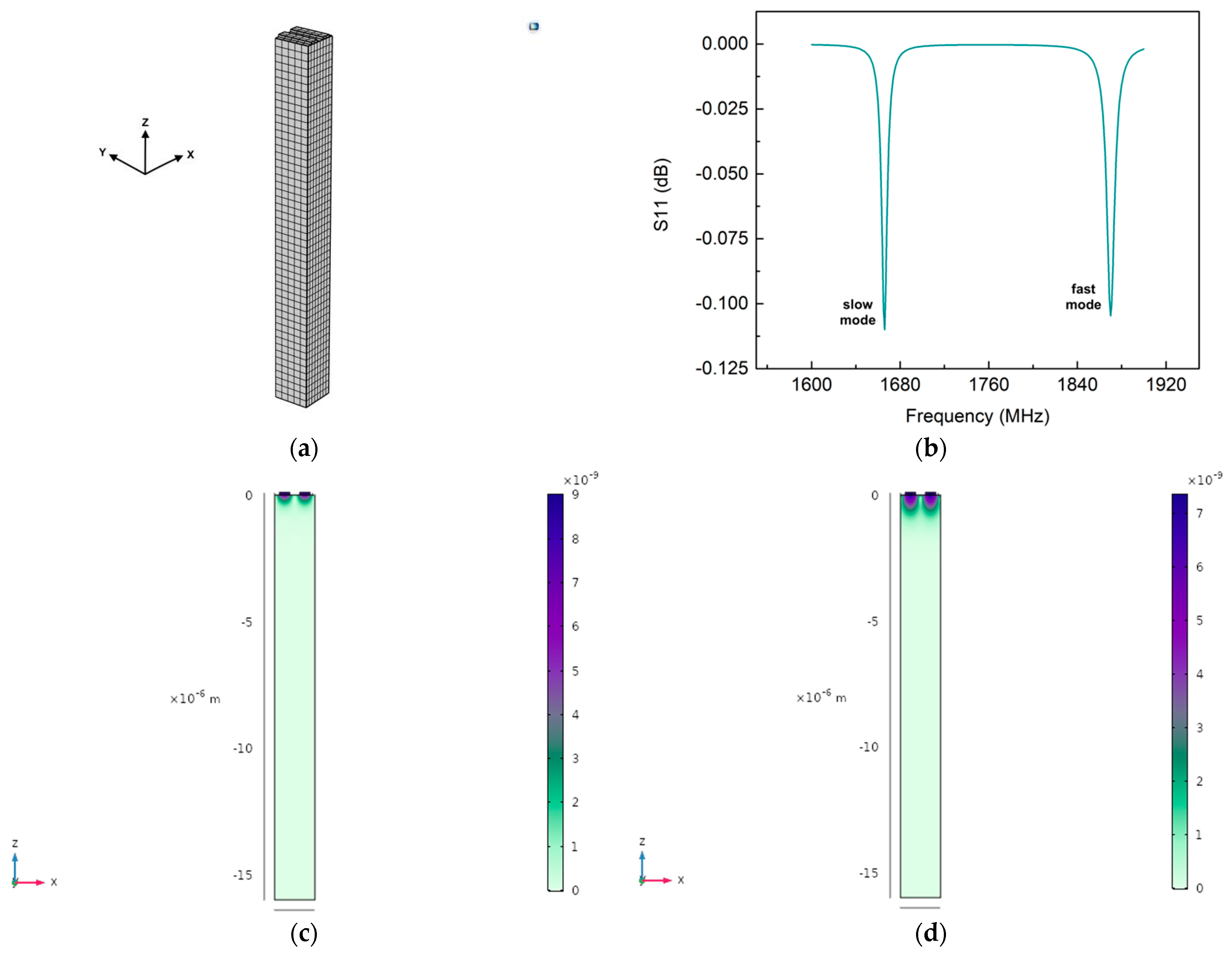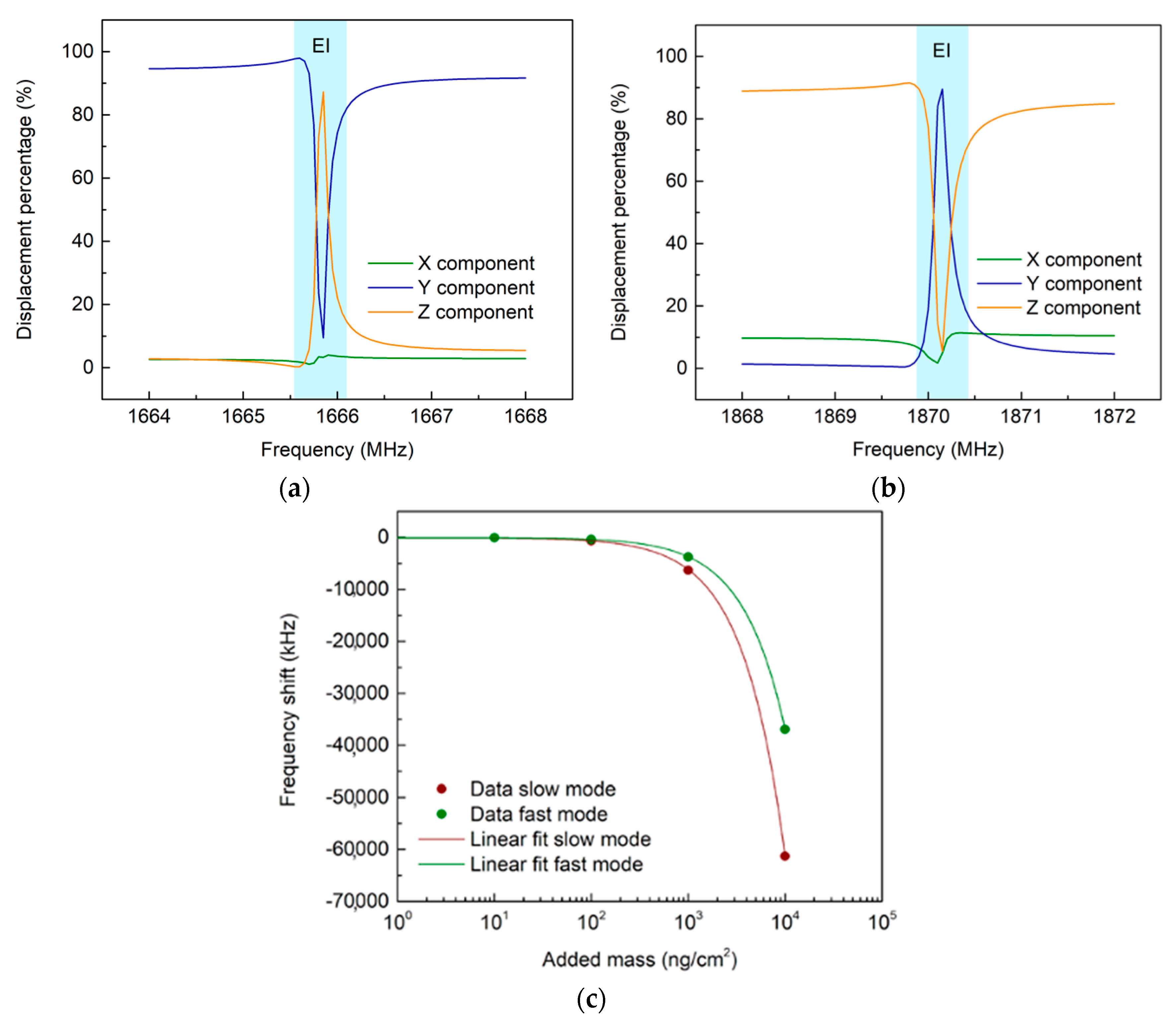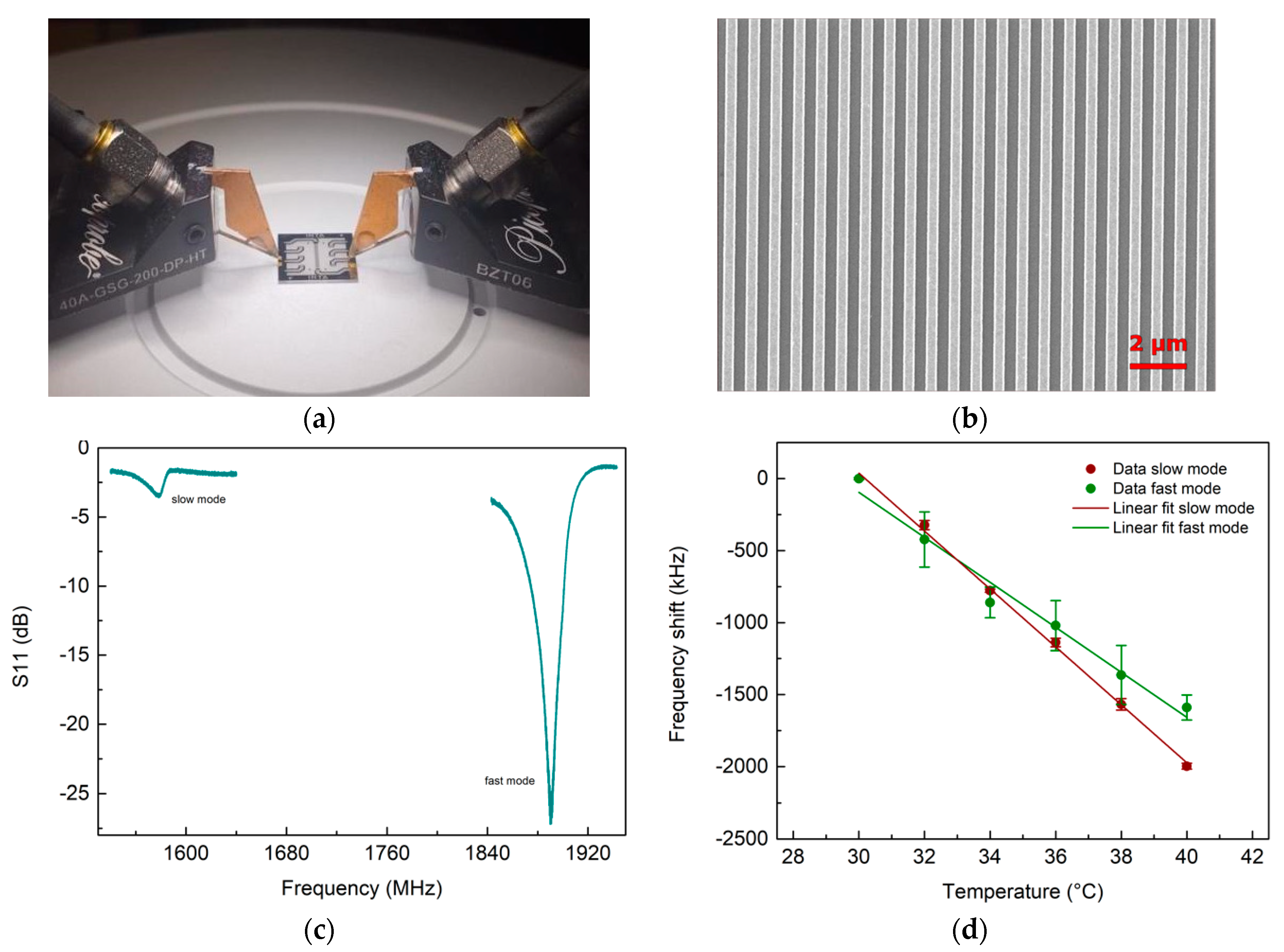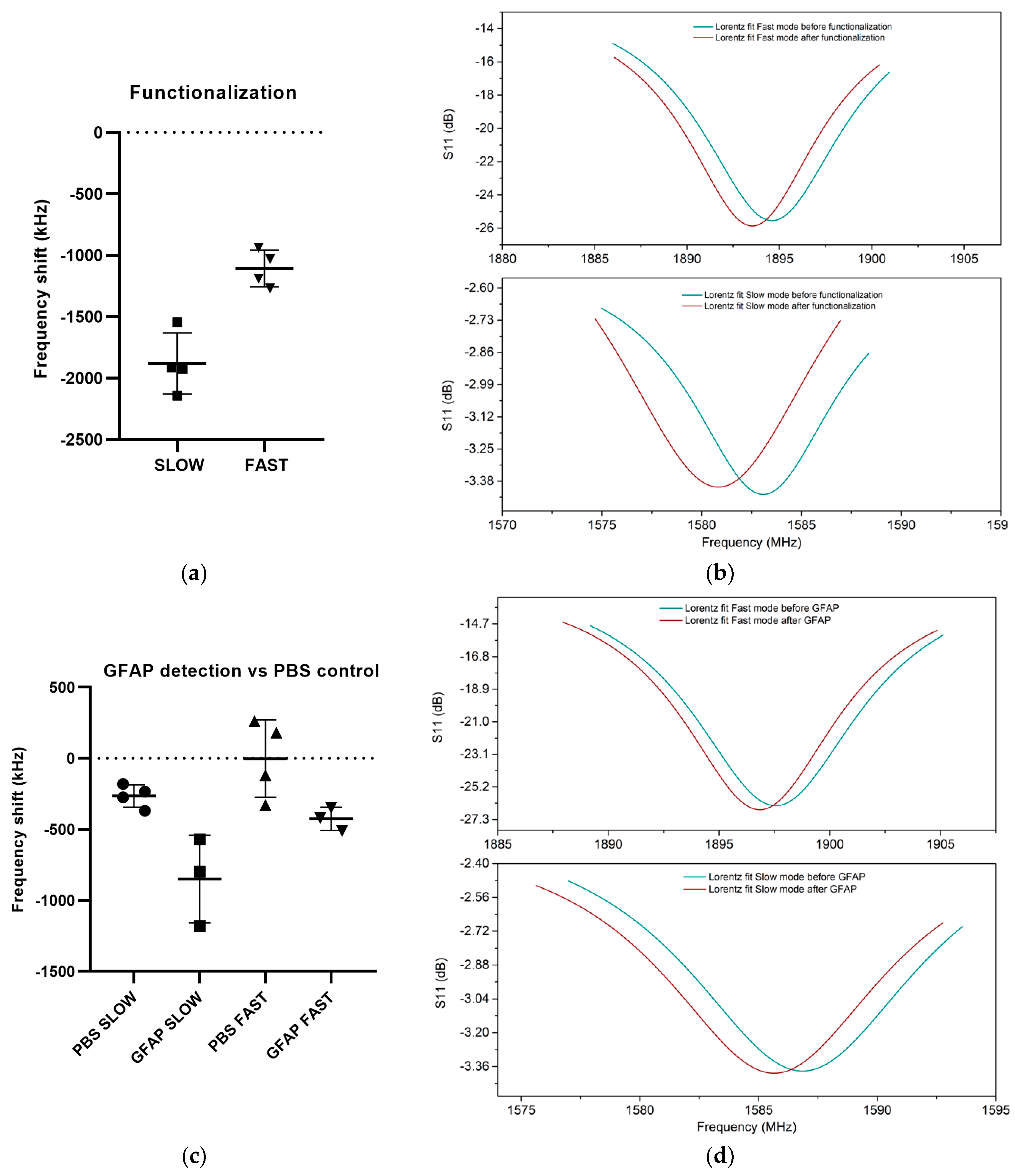Mode Characterization and Sensitivity Evaluation of a Surface Acoustic Wave (SAW) Resonator Biosensor: Application to the Glial-Fibrillary-Acidic-Protein (GFAP) Biomarker Detection
Abstract
1. Introduction
2. Materials and Methods
2.1. Ultra-High-Frequency Surface-Acoustic-Wave Resonator Biosensors
2.2. Functionalization and Detection Protocols
- cleaning of chips performed by sonication in acetone (ACE), isopropanol (IPA), and deionized (DI-) water for 7 min each;
- drying of the chips with a stream of nitrogen;
- half-antibody functionalization incubated for 30 min with a solution made of 2 μL pAb (anti-GFAP polyclonal antibody, Synaptic System, 173-002), 4 μL DTT (DL-Dithothreitol 5 g, by SIGMA ALDRICH) at a concentration of 1.5 mg/mL, 34 μL PBS 1X (phosphate buffer saline);
- wash in DI-water for 5 min;
- drying the chips with a stream of nitrogen and waiting 1 h before use.
- recombinant GFAP (Synaptic Systems, 173-0P) 1000 nM in PBS, or clean PBS for the negative control, incubated for 30 min;
- wash in DI-water for 5 min;
- drying of the chips with a stream of nitrogen;
- pAb for 30 min;
- wash in DI-water for 5 min;
- drying of the chips with a stream of nitrogen.
2.3. Measurement Setup and Acquisition Protocol
3. Results and Discussion
3.1. Finite-Element-Modelling Simulations
3.2. UHF-SAW Biosensors
4. Conclusions
Author Contributions
Funding
Data Availability Statement
Conflicts of Interest
References
- Bhalla, N.; Jolly, P.; Formisano, N.; Estrela, P. Introduction to biosensors. Essays Biochem. 2016, 60, 1–8. [Google Scholar] [CrossRef] [PubMed]
- Turner, A.P.F. Biosensors: Sense and sensibility. Chem. Soc. Rev. 2013, 42, 3184–3196. [Google Scholar] [CrossRef] [PubMed]
- Naresh, V.; Lee, N. A review on biosensors and recent development of nanostructured materials-enabled biosensors. Sensors 2021, 21, 1109. [Google Scholar] [CrossRef] [PubMed]
- Grieshaber, D.; Mackenzie, R.; Vörös, J.; Reimhult, E. Electrochemical Biosensors-Sensor Principles and Architectures. Sensors 2008, 8, 1400–1458. [Google Scholar] [CrossRef] [PubMed]
- Pashchenko, O.; Shelby, T.; Banerjee, T.; Santra, S. A Comparison of Optical, Electrochemical, Magnetic, and Colorimetric Point-of-Care Biosensors for Infectious Disease Diagnosis. ACS Infect. Dis. 2018, 4, 1162–1178. [Google Scholar] [CrossRef] [PubMed]
- Wenzel, S.W.; White, R.M. Analytic comparison of the sensitivities of bulk-wave, surface-wave, and flexural plate-wave ultrasonic gravimetric sensors. Appl. Phys. Lett. 1989, 54, 1976–1978. [Google Scholar] [CrossRef]
- Agostini, M.; Cecchini, M. Ultra-high-frequency (UHF) surface-acoustic-wave (SAW) microfluidics and biosensors. Nanotechnology 2021, 32, 312001. [Google Scholar] [CrossRef]
- Mandal, D.; Banerjee, S. Surface Acoustic Wave (SAW) Sensors: Physics, Materials, and Applications. Sensors 2022, 22, 820. [Google Scholar] [CrossRef] [PubMed]
- Huang, Y.; Das, P.K.; Bhethanabotla, V.R. Surface acoustic waves in biosensing applications. Sens. Actuators Rep. 2021, 3, 100041. [Google Scholar] [CrossRef]
- Greco, G.; Agostini, M.; Cecchini, M. Ultra-High-Frequency Love Surface Acoustic Wave Device for Real-Time Sensing Applications. IEEE Access 2020, 8, 112507–112514. [Google Scholar] [CrossRef]
- Rocha-Gaso, M.I.; March-Iborra, C.; Montoya-Baides, Á.; Arnau-Vives, A. Surface Generated Acoustic Wave Biosensors for the Detection of Pathogens: A Review. Sensors 2009, 9, 5740–5769. [Google Scholar] [CrossRef] [PubMed]
- Agostini, M.; Greco, G.; Cecchini, M. Full-SAW Microfluidics-Based Lab-on-a-Chip for Biosensing. IEEE Access 2019, 7, 70901–70909. [Google Scholar] [CrossRef]
- Agostini, M.; Lunardelli, F.; Gagliardi, M.; Miranda, A.; Lamanna, L.; Luminare, A.G.; Gambineri, F.; Lai, M.; Pistello, M.; Cecchini, M. Surface-Acoustic-Wave (SAW) Induced Mixing Enhances the Detection of Viruses: Application to Measles Sensing in Whole Human Saliva with a SAW Lab-On-a-Chip. Adv. Funct. Mater. 2022, 32, 2201958. [Google Scholar] [CrossRef]
- Shiokawa, S.; Matsui, Y.; Ueda, T. Liquid streaming and droplet formation caused by leaky Rayleigh waves. Ultrason. Symp. Proc. 1989, 1, 643–646. [Google Scholar] [CrossRef]
- Greco, G.; Agostini, M.; Tonazzini, I.; Sallemi, D.; Barone, S.; Cecchini, M. Surface-Acoustic-Wave (SAW)-Driven Device for Dynamic Cell Cultures. Anal. Chem. 2018, 90, 7450–7457. [Google Scholar] [CrossRef] [PubMed]
- Hyder, A.A.; Wunderlich, C.A.; Puvanachandra, P.; Gururaj, G.; Kobusingye, O.C. The impact of traumatic brain injuries: A global perspective. NeuroRehabilitation 2007, 22, 341–353. [Google Scholar] [CrossRef] [PubMed]
- Okonkwo, D.O.; Yue, J.K.; Puccio, A.M.; Panczykowski, D.M.; Inoue, T.; McMahon, P.J.; Sorani, M.D.; Yuh, E.L.; Lingsma, H.F.; Maas, A.I.R.; et al. GFAP-BDP as an acute diagnostic marker in traumatic brain injury: Results from the prospective transforming research and clinical knowledge in traumatic brain injury study. J. Neurotrauma 2013, 30, 1490–1497. [Google Scholar] [CrossRef] [PubMed]
- Abdelhak, A.; Foschi, M.; Abu-Rumeileh, S.; Yue, J.K.; D’Anna, L.; Huss, A.; Oeckl, P.; Ludolph, A.C.; Kuhle, J.; Petzold, A.; et al. Blood GFAP as an emerging biomarker in brain and spinal cord disorders. Nat. Rev. Neurol. 2022, 18, 158–172. [Google Scholar] [CrossRef] [PubMed]
- Agostini, M.; Greco, G.; Cecchini, M. A Rayleigh Surface Acoustic Wave (R-SAW) Resonator Biosensor based on Positive and Negative Reflectors with Sub-Nanomolar Detection Limit. Biosens. Bioelectron. 2017, 92, 555–561. [Google Scholar] [CrossRef]
- Morgan, D. Surface Acoustic Wave Filters: With Applications to Electronic Communications and Signal Processing, 2nd ed.; Elsevier: Oxford, UK, 2007. [Google Scholar]
- Chen, X.; Mohammad, M.; Conway, J.; Liu, B.; Yang, Y.; Ren, T.-L. High performance lithium niobate surface acoustic wave transducers in the 4-12 GHz super high frequency range. J. Vac. Sci. Technol. B 2015, 33, 06F401. [Google Scholar] [CrossRef]




Disclaimer/Publisher’s Note: The statements, opinions and data contained in all publications are solely those of the individual author(s) and contributor(s) and not of MDPI and/or the editor(s). MDPI and/or the editor(s) disclaim responsibility for any injury to people or property resulting from any ideas, methods, instructions or products referred to in the content. |
© 2023 by the authors. Licensee MDPI, Basel, Switzerland. This article is an open access article distributed under the terms and conditions of the Creative Commons Attribution (CC BY) license (https://creativecommons.org/licenses/by/4.0/).
Share and Cite
Passeri, A.M.; Lunardelli, F.; Cavariani, D.; Cecchini, M.; Agostini, M. Mode Characterization and Sensitivity Evaluation of a Surface Acoustic Wave (SAW) Resonator Biosensor: Application to the Glial-Fibrillary-Acidic-Protein (GFAP) Biomarker Detection. Micromachines 2023, 14, 1485. https://doi.org/10.3390/mi14081485
Passeri AM, Lunardelli F, Cavariani D, Cecchini M, Agostini M. Mode Characterization and Sensitivity Evaluation of a Surface Acoustic Wave (SAW) Resonator Biosensor: Application to the Glial-Fibrillary-Acidic-Protein (GFAP) Biomarker Detection. Micromachines. 2023; 14(8):1485. https://doi.org/10.3390/mi14081485
Chicago/Turabian StylePasseri, Antonio Matteo, Francesco Lunardelli, Daniele Cavariani, Marco Cecchini, and Matteo Agostini. 2023. "Mode Characterization and Sensitivity Evaluation of a Surface Acoustic Wave (SAW) Resonator Biosensor: Application to the Glial-Fibrillary-Acidic-Protein (GFAP) Biomarker Detection" Micromachines 14, no. 8: 1485. https://doi.org/10.3390/mi14081485
APA StylePasseri, A. M., Lunardelli, F., Cavariani, D., Cecchini, M., & Agostini, M. (2023). Mode Characterization and Sensitivity Evaluation of a Surface Acoustic Wave (SAW) Resonator Biosensor: Application to the Glial-Fibrillary-Acidic-Protein (GFAP) Biomarker Detection. Micromachines, 14(8), 1485. https://doi.org/10.3390/mi14081485







